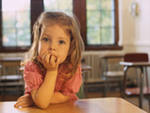Translate into Russian paying attention to the construction there is/are.
1. There is a newspaper on the table. 2. What books are there on the table? 3. There is a picture in my sister’s flat. 4. Are there any doctors in the room? 5. There are some chairs in the hall. 6. Is there a cinema round the corner? 7. There’s a new restaurant in King Street. 8. Is there any university in that town? 9. There are many fine buildings in Moscow. 10. Is there a mistake in this sentence? — No, there isnt’t. 11. Is there any time for reading? — Yes, there is.
Make the sentences negative and interrogative according to the Model.
Model: There is a blackboard in our classroom. — There is no blackboard in our classroom. Is there a blackboard in your classroom?
1. There are some English books on the table. 2. There are many mistakes in your dictionary. 3. There’s a new grammar rule in Lesson 7 Seven. 4. There is a telegram on the table. 5. There is too little water in the jug.
Choose the correct form of the verb to be.
1. There (is, are) a large TV in my room. 2. There (is, are) three windows in my classroom. 3. There (is, are) a table and four chairs in my sister’s room. 4. There (is, are) a school here. 5. There (is, are) very many children in the park. 6. There (is, are) many people in the street. 7. There (is, are) a lot of snow outside the window. 8. There (isn’t, aren’t) any copybooks on this table. 9. There (is, are) interesting films on TV. 10. (Is, are) there any supermarkets in your town?
What is there on the table?
There is a book on the table. / There are some books on the table.
Put questions to the italicized words according to the Model.
Model: There is a nice sofa in your room. — What is there in your room?
1. There is a nice garden before your house. 2. There are five chairs in the room. 3. There are three mistakes in my dictation. 4. There is a new cinema near my house. 5. There are many animals in the Zoo. 6. There are some Englishmen at the conference.
THE TEACHER AND THE PUPILS. AT THE LESSON
THE TEACHER AND THE PUPILS
TEACHER: I am the teacher. I am Miss Bell. What are you?
CLASS: We are pupils.
TEACHER: Are you a pupil, Jane?
JANE: Yes, I am a pupil.
TEACHER: Are you a pupil, Kate?
KATE: Yes, I am.
TEACHER: Are you in the classroom, John?
JOHN: Yes, I am in the classroom.
TEACHER: Who are you?
CHRIS: I am Chris.
TEACHER: How are you, Chris?
CHRIS: I am very well, thank you.
TEACHER: What are you all?
CLASS: We are all pupils.
TEACHER: How many pupils are there in the class?
KATE: There are fifteen.
TEACHER: That’s right. Thank you, Kate.
Ex. 1 Choose AM/ IS / ARE
1. I … a student. 2. He … a pupil. 3. You … a teacher. 4. Mr.Bell … a man. 5. Mary … a girl. 6. The desks … in the classroom. 7. We … students. 8. What … you? 9. What … Henry? 10. Who … you? 11. Who … I? 12. … I a student? 13. … he a pupil? 14. … she a teacher? 15. … I the teacher? 16. There … one clock in the classroom. 17. … there three books in the class? 18. There … ten desks in the room. 19. There … a door in the classroom. 20. There … fifteen pupils in the class.
Ex. 2 Answer the questions
1)  Who are you? 2) How are you? 3) Are you a student? 4) What are you all? 5) How many students are there in the class? 6) How many books are there on the shelf/ in the bookcase? 7) How many windows are there in the room?
Who are you? 2) How are you? 3) Are you a student? 4) What are you all? 5) How many students are there in the class? 6) How many books are there on the shelf/ in the bookcase? 7) How many windows are there in the room?
Ex.3 Make the questions
1. I am a teacher. 2. You are in the classroom. 3. We are all students. 4. Some of the students are girls. 5. The answer if right. 6. They are here. 7. He is near the window. 8. There are only two books on the bookshelf.
PRESENT CONTINUOUS TENSE

+ am/is/are +Ving
| STATEMENT | NEGATIVE | QUESTION |
| I am speaking. | I am not speaking. | Am I speaking? |
| He is speaking. | He is not speaking. | Is he speaking? |
| She is speaking. | She is …. speaking. | … she speaking? |
| We are speaking. | We … … speaking. | … we speaking? |
| You are speaking. | You … … speaking. | … … speaking? |
| They are speaking. | They … … speaking. | … … speaking? |
